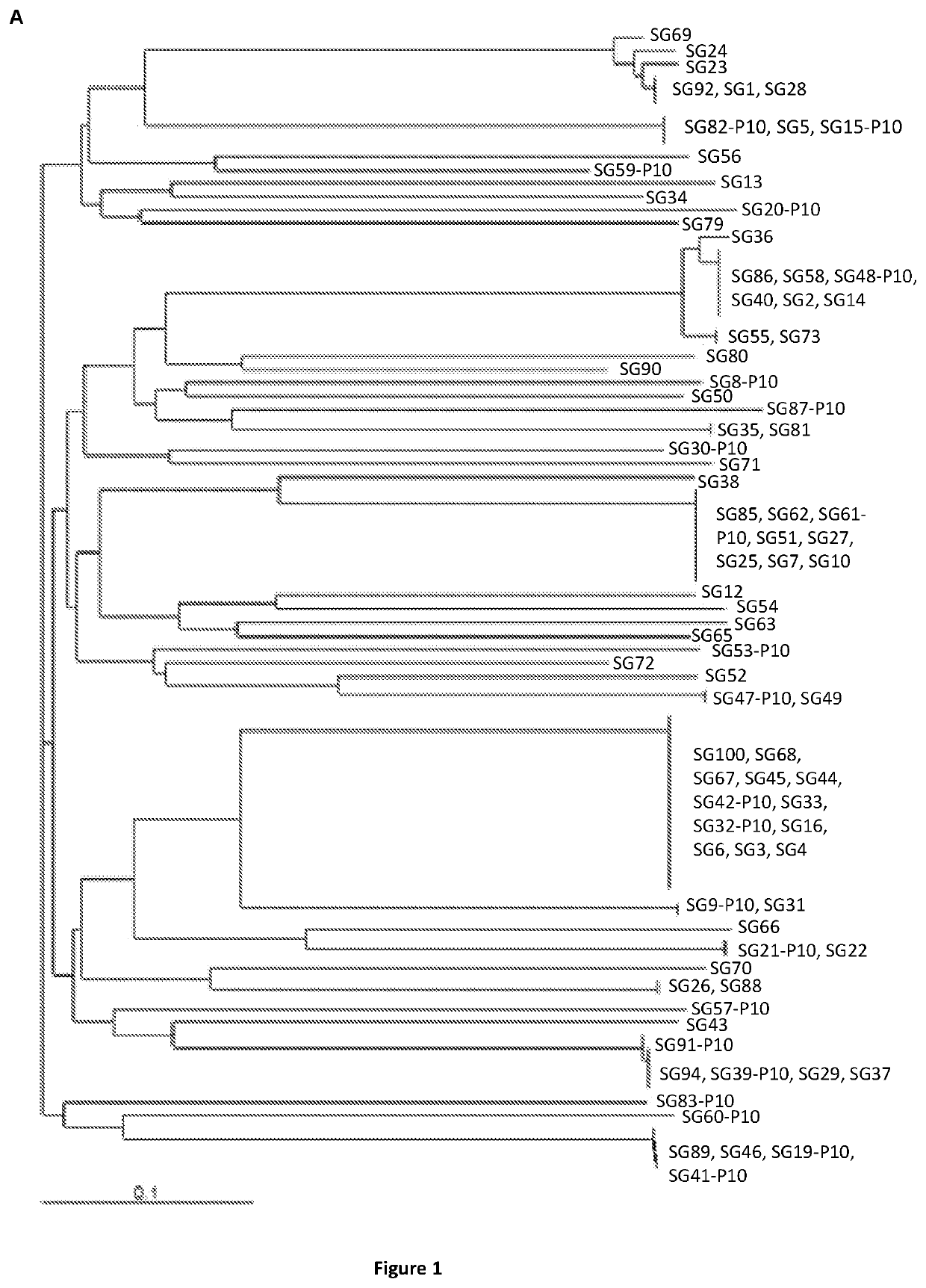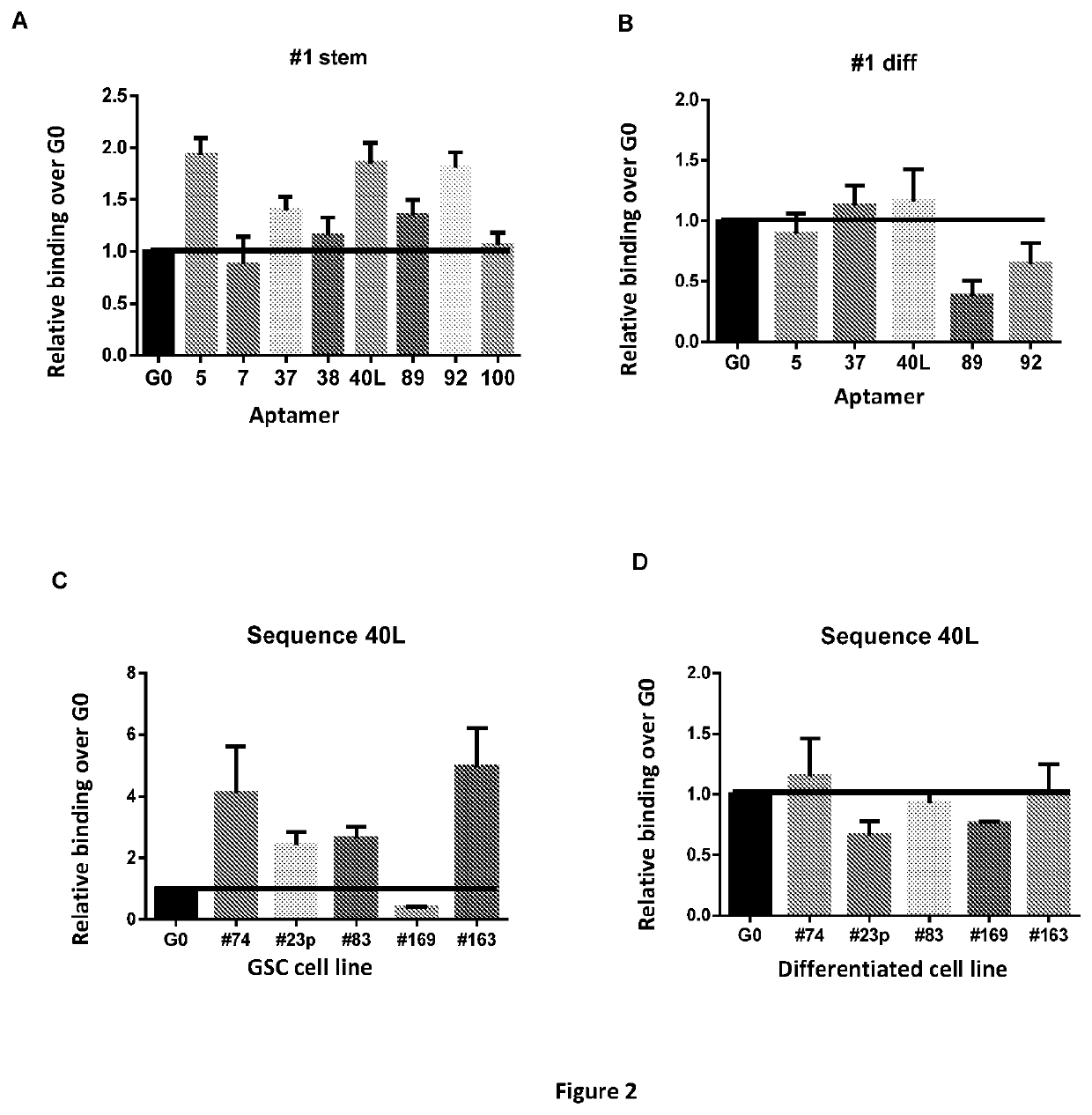Aptamers against glioblastoma
a technology of glioblastoma and aptamers, which is applied in the field of nucleic acid compounds, can solve the problems of dismal prognosis of gbm patients
- Summary
- Abstract
- Description
- Claims
- Application Information
AI Technical Summary
Benefits of technology
Problems solved by technology
Method used
Image
Examples
example 1
and Methods
Glioblastoma Stem-Cell Isolation and Differentiation
[0240]GBM tissue samples were obtained from the Institute of Neurosurgery, School of Medicine, Universitá Cattolica, Rome, Italy after craniotomy of adult patients (as described by Pallini et al., 2008) from which, before surgery, informed consent was obtained. Mechanical dissociation of GBM tumor specimens allowed stem cell isolation, as previously described (Ricci-Vitiani et al., 2010, Pallini et al., 2008). Cells were then cultured in a serum-free medium supplemented with EGF and bFGF. Differentiation was induced by plating cells on flasks coated with BD Matrigel™ Basement Membrane Matrix (BD Biosciences) in the presence of 10% serum and absence of EGF and bFGF for 2 weeks.
Whole-Cell SELEX
[0241]The SELEX cycle was performed essentially as described elsewhere (Fitzwater and Polisky, 1996). Given the resistance to degradation against serum nucleases provided by the fluoropyrimidine, transcription was performed in the pr...
example 2
SELEX Selection
[0257]In order to isolate aptamers able to distinguish in the tumor mass the rare population of glioma cells growing as stem-like non-adherent spheres, we adopted a differential cell-SELEX approach, using primary glioma stem cell lines derived from two patients. The GSC #1 line was derived from a patient diagnosed with neural glioblastoma; the GSC #83 line was from a patient diagnosed with mesenchymal glioblastoma. Cell lines were propagated as non-adherent spheres in minimal F12 medium supplemented with cell growth factors (EGF and basic FGF), as previously described [12], and alternately used as targets in the SELEX process. Stem features were evaluated by assessing major stem cells markers. At each round, selection was preceded by one or two counterselection steps, incubating the pool with adherent GSC #1 or GSC #83 cells. For counterselections, GSC #1 or GSC #83 lines were grown as adherent cells on a matrigel substrate for two weeks in serum-containing F12 medium...
example 3
n
[0264]Glioblastoma is the most common primary brain tumor of adulthood: it is the most aggressive form of glioma, corresponding to grade IV based on WHO classification (Louis et al., 2016, Urbanska et al., 2014). Given the high capacity to invade normal brain tissue, GBM is still particularly difficult to be completely removed surgically. Despite many studies aimed at improving treatment efficacy, overall survival has not increased in a significant way over recent years. Poor prognosis is mainly caused by the almost universal recurrence of GBM within 6-9 months from treatment. GBM is a heterogeneous tumor consisting of differentiated cells and a small population of cancer stem cells (Pallini et al., 2008, Singh et al., 2003). GSCs are responsible for tumor initiation, growth, and recurrence and, thus, represent an ideal target to increase the overall survival of GBM patients.
[0265]In the present work, we addressed GSC targeting, using a nucleic acid-based aptamer. Indeed, aptamers ...
PUM
| Property | Measurement | Unit |
|---|---|---|
| mass | aaaaa | aaaaa |
| pH | aaaaa | aaaaa |
| pH | aaaaa | aaaaa |
Abstract
Description
Claims
Application Information
 Login to View More
Login to View More - R&D
- Intellectual Property
- Life Sciences
- Materials
- Tech Scout
- Unparalleled Data Quality
- Higher Quality Content
- 60% Fewer Hallucinations
Browse by: Latest US Patents, China's latest patents, Technical Efficacy Thesaurus, Application Domain, Technology Topic, Popular Technical Reports.
© 2025 PatSnap. All rights reserved.Legal|Privacy policy|Modern Slavery Act Transparency Statement|Sitemap|About US| Contact US: help@patsnap.com



